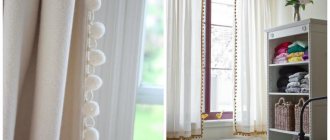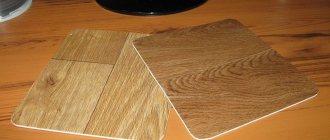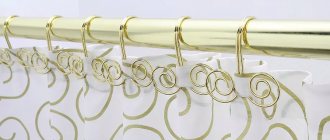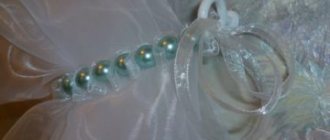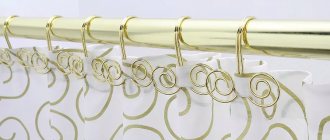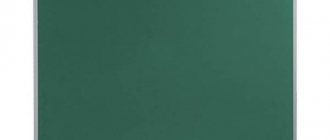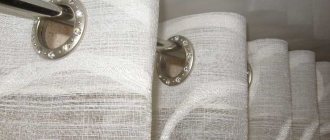To avoid curling and deformation of curtains, use a special weighting material for curtains. The device also performs other functions. Some curtains are equipped with a weight directly when sewing at the factory. But if the canvas does not have such additional elements, then you can install them yourself.
Curtains and curtains that curl at the edges often cannot be straightened by ironing and steaming.
The solution to the problem is curtain weights.
Sewing process
The production of tulle should begin by aligning its end sections, which will subsequently become its side seams. This should be done if, during cutting, the fabric was cut (or even torn) unevenly.
Articles on the topic (click to view)
- Washing machine repair
- Curtain design for the kitchen 2022
- Stylish curtains for the hall, fashionable in 2022
- Fashionable curtains for the hall in 2022
- Photo of interior design 2022 with curtains
- Step-by-step instructions for creating Japanese curtains with your own hands
- Photo of the kitchen and bedroom interior with Japanese curtains
If the structure of the fabric allows it (veil, gauze), you can pull out one thread next to the cut and cut off the uneven edge along the trace left from it.
In cases where pulling the thread is impossible (organza), the fabric should be placed on the floor or table, using chalk and a long ruler, draw an even side cut line and align the curtain along it.
The weighting along the bottom edge of the curtain will interfere with processing the side seams. Therefore, you should very carefully remove the tail of the textile cord with beads from the overlock stitch and trim it to the width of the side seam allowance plus 1 cm.
Expert opinion
Romanova Ksenia Petrovna
Interior design expert and fabric store manager
So, if the finished side seam should have a width of 2 cm, the width of its seam allowance will be 4 cm. Then the weighting material must be cut to 5 cm.
After this, the overlock stitch needs to be carefully straightened so that the weighting material “goes” inside.
Then you should prepare the side seams of the tulle for processing - first you need to iron them 4 cm to the wrong side, and then turn them inward one more time (2 cm) and iron them again. To prevent the side seams from warping during the stitching process, they can be pinned in some places.
Next you need to stitch along the side seams of the tulle. The treated side seams should be pulled back, secured with pins on the ironing surface in a slightly taut state, ironed and left to cool completely. Treated in this way, the side seams will turn out perfectly smooth and will not “bounce” or bulge.
Then you should process the top edge of the tulle.
Up from the weighting material, you need to measure the height of the finished tulle (this method is suitable for curtains hanging on ceiling cornices 1 cm thick). After this, from this control mark you need to set aside 2 more widths of the curtain tape plus 2 cm.
So, if the ribbon has a width of 5 cm, then a total of 12 cm will need to be set aside. It is at this mark that the excess height of the tulle must be trimmed.
The straightened cut should be ironed on the wrong side, first 12 cm, and then, turning 6 cm inward, ironed again. To make it more convenient to iron the edge of the tulle, as well as to sew the curtain tape, you can use pins that will securely fasten all layers of fabric together.
Then you should stitch the curtain tape. It should be placed 1 cm from the top edge of the tulle.
The end sections of the braid at the beginning and end of the stitching should be turned inward by 1.5-2 cm. The holding threads from one edge should be brought out to the wrong side and tied in a knot.
Otherwise they will pop out when the tulle is pulled together. The first line should be laid 2 mm from the top edge of the curtain tape.
Then, using pins, you need to secure the lower edge of the braid. This will prevent the tulle from twisting and shrinking relative to the braid.
The second line along the curtain tape should be laid at a distance of 2 mm from its bottom edge. From the other edge, the holding threads should be brought to the front side of the braid. You will need to pull on them to gather the tulle into folds.
The treated tulle should be pulled to the width of the cornice. The holding threads must be tied in a knot, their ends wound like a ball, tied with tails of the threads and tucked between the tulle and the curtain braid.
When the need arises (for example, for washing or ironing), the threads can always be untied and unraveled.
How to properly connect curtain tape with tulle
Types of hooks for curtains and curtains: how to make them yourself
Sometimes it is not possible to turn to the services of an atelier. In this case, you will need knowledge of how to sew curtain braid to tulle.
To immediately achieve a good result, you need to correctly calculate the length of the fabric and braid.
Step-by-step instructions on how to do it yourself
To complete the job efficiently, follow the step-by-step instructions.
To gain the necessary skills, professionals advise practicing on inexpensive tulle, since delicate material is easy to ruin.
Important! Make sure that the loops on the tape are facing you, that is, they are on the outside. This will allow you to attach the tulle to the curtain rod hooks.
To begin with, the curtain material is measured and cut. Then, measure the length of the curtain tape. To do this, add 25-50 centimeters to the length of the tulle. This allowance is needed for additional folds and to take into account the shrinkage of the material after washing.
This method can be used to process curtains that are made of light and transparent fabrics.
Processing side cuts of material. We bend the tulle to the wrong side. If your tulle is fraying a lot, then it should be tucked not once, but twice.
After that, iron the fabric and sew.
Bring the ribbon and curtain together to make it easier to sew them on in the future.
The length of the curtain tape should be 4-6 cm longer than the fabric.
Apply the braid one and a half centimeters below the edge, fold the edges of the braid on each side.
We sew a line along the curtain tape, bending the edges of the curtain tape to the wrong side.
Carefully sew the ribbon to the curtain. Then remove the running stitches and pins.
We lay a line along the upper edge of the curtain tape, where the pockets are located.
Next, sew the ribbon on the sides.
We tie the laces of the curtain tape on one edge, and tighten the laces on the other side.
Peculiarities
No matter how heavy the curtain may seem, it is still easily moved by the air flow. That’s why special weights are needed in many ways to help hold the canvas in place. Weighting elements vary in thickness and weight. There is only one selection rule: the higher the density of the curtain fabric, the heavier the part used should be.
It can be used for:
- Roman curtains;
- Japanese curtains;
- roller blinds;
- Hungarian curtains;
- heavy curtains.
Thanks to the increased load, it is ensured:
- maintaining the required shape;
- accelerated straightening of folded fabric;
- always attractive appearance.
Possible modifications
There are weights in the form of tape or oblong weights. There are also options with a cord and based on round elements with holes.
All types differ in their specific area of application. But the desired loads are not always included in the delivery of curtains.
When making an additional purchase, difficulties may be associated with an inflated price or even a complete lack of goods on sale.
Weighting parts can be made by hand. The simplest of them are sewn into the lower edges of curtains. Cords are also used when sewing light curtains and tulle. A good replacement for them are steel chains or pieces of thin wire. Rail-type weights are inserted into the folded edges of the curtains.
You need to sew on the slats:
- manually;
- on a sewing machine (using a zigzag seam);
- on an overlocker.
A simple fold of the bottom edge of the curtain and pulling the chain through in the case of opaque material looks pretty good. But this option is not suitable when the curtain is made of transparent fabric. Then weighting them with their own canvas comes to the rescue. The technique is very simple: fold the edge from below twice by 100 mm.
The following can also be used to replace the tape:
- wooden slats;
- thin steel tubes;
- metal pins.
External weight for weighting
Instead of filling the inside of the curtain with various elements, you can hang a load from the outside. Then weights with various holes, as well as weights, are used.
From available means, such products can be easily replaced with unnecessary worn-out coins. Serially supplied weights are mainly made either round (that’s when holes are needed) or elongated conical parts.
Most often, such designs are sewn into spreads from the sides.
Additional Information
Expert opinion
Romanova Ksenia Petrovna
Interior design expert and fabric store manager
Placing them inside cuffs and seams allows you to hide weights from prying eyes. Therefore, the choice of a suitable device is strictly individual.
Almost anything you can pick up will do. Curtains are mainly complemented with plates and cords.
Since these elements have an external part, it is very important that they complete the composition and bring it to perfection.
When it is planned to maintain the geometry of the curtain only at the corners, a special kind of plate is used. Most often, the delivery kit already includes mounting brackets. Such devices help fix the weighting material in the bottom hem.
For Roman blinds, weighting agents are selected in the form of:
Particular attention should be paid to the selection of weights mounted on bath curtains. In this case, only a steel chain is suitable; occasionally it is replaced with rods and small balls. Another option is several magnets. This solution is optimal for a steel or cast iron bathtub. If it is made of other materials, it will not fit well.
How to hem tulle with weighting is described in the video below.
Sizes and colors
The length of voile curtains can be slightly higher/lower than the window sill, on the floor, not reaching it by 5-8 cm, or exceeding the height of the room. In the latter case, the bottom of the curtains is draped on the floor.
Short tulle is appropriate in the kitchen. Products that do not touch the floor get dirty less and make it easy to wet clean underneath them. A floor-length veil looks more elegant and stylish.
Cornices are mounted on the wall above the window or on the ceiling.
Not so long ago, a refreshing white color was considered traditional for tulle. Today preference is given to pastel colors - milky, peach, light green, lavender, pink.
A rainbow veil combines several fabrics made in different colors and sets the mood for positivity, while tulle with an ombre effect differs from other multi-color curtains in its smooth transition of shades, which brings unusualness and sophistication to the interior.
Characteristics and purpose of using weighting materials
Even heavy curtains are not stable and are easily moved by the wind. To fix the curtains in one place, special weights are provided. Such devices have different weights, thicknesses, and modifications.
A special weighting device ensures the much-desired evenness of the lines.
Important! When choosing a weighting agent, you need to rely on the density of the fabric. The higher it is, the greater the mass of the element used should be.
Which curtain models need additional load.
- Roman. Curtains have a mechanism that lifts the fabric and rolls it onto the curtain rod. The design is additionally equipped with a wooden or plastic slats.
- Japanese. These are fabric sheets that are weighted with metal, wood or plastic slats. They are secured with glue.
- Curtains in the bathroom. Small magnets or plastic parts are used as weights to prevent deformation of the waterproof fabric.
- Tulle. Lightweight sheer fabric can only be finished with lace.
- Heavy curtains. Here it is recommended to use metal balls and cylinders.
You can make a weighting agent from available items (ribbon, cord, metal parts, slats are suitable).
In each specific case, the choice of weighting material is determined by the properties of the fabric.
The weighting material allows you to maintain the necessary shape of the curtains and prevents the curtains from deforming. In addition, this detail helps to quickly straighten the curtains. Thanks to a small load, the tulle will always look neat.
Cord and ribbon are used if the main material of the curtains is tulle, organza or other light fabrics.
Similarities and differences between veil and organza
Fabrics for decorating window and door openings have similar qualities, not only in their purpose and color schemes.
Tulle curtains
Tulle veil:
- denser than organza;
- soft texture;
- matte canvas;
- good light transmission;
- easily forms compositions in curtain drapery;
- Smooth fabric to the touch.
On a note! Disadvantages include poorly removed stains and fading under the influence of sunlight, low strength and high creasing of the canvas.
The appearance of hooks that can ruin not only the appearance, but the integrity of the curtain.
White tulle veil
Organza does not allow air to pass through well. More expensive, but less elegant compared to the veil. High strength allows use in the kitchen and hallway. Washes well. The texture is more rigid, and the surface has a shine. Not suitable for use on the sunny side, or requires additional thick curtains
On a note! There is no clear answer to the question of veil or organza, which is better. It all depends on where the curtain from a particular fabric will be used.
Veil
Translucent fabric, designed to decorate the interior of a room and hide imperfections in repairs or personal life from prying eyes, is called a veil. Curtains made from this fabric can visually change the size of the space within the room. Horizontal stripes will expand a narrow room, while vertical stripes will make low ceilings appear higher. Excellent protection from the sun and creating a romantic design with the power of a white veil.
One of the disadvantages of the veil is the susceptibility of the canvas to electrification, which attracts dust particles and contaminates the curtains. Stains are difficult to remove, so curtains made from this fabric are not recommended for use in the kitchen. Perfect for darkening a room on the sunny side. Tulle veil or organza, which is better, no one can answer, because the use of both is possible even within the same lambrequin-type design.
You might be interested in Description of non-woven fabric: what kind of fabric is it, where and how is it used
Colored organza
Organza
Tulle fabric, characterized by strength and rigidity, is a type of organza. The advantages of the material are:
- tensile strength;
- light transmittance;
- durability in operation;
- does not fade in the sun;
- ability to keep shape due to rigidity;
- Resistant to cleaning solvents.
Its use in decorative elements in the form of bows and curtain tiebacks echoes its use in decorating wedding halls, decorating motorcade cars and arranging flower arrangements.
Blue organza
Disadvantages include capriciousness in cut and the need for special care. The bright shimmer of glossy fabric can easily be ruined by a hot iron when ironing, creating a hole.
Modern technologies use fabric for printing designs, machine embroidery and gold plating. One of the latest varieties of organza is “chameleon” fabric, cast in different shades when exposed to light.
What distinguishes tulle from organza is its softness and ability to form beautiful folds when decorating a lambrequin.
Microveil
Microveil and veil: the difference
The fabric appeared on the market relatively recently, and is considered a new product among tulle materials. It is considered a micro-veil, which is characterized by softness, and a semi-organza, which has elasticity and the ability to transmit sunlight.
A new type of material does not lose shape after washing, does not fade in the sun and does not shrink. Combining the positive qualities of a veil and organza in one fabric. Therefore, the question of which is better, semi-organza or veil, is not entirely relevant.
Weighted with fringed ribbon
The new generation fabric is stronger than veil and thin as organza. The microveil drapes into beautiful folds, improving the visual perception of the space of the room.
In the production of new items, various fibers are used - silk, linen, cotton and wool, synthetics. The color design is multifaceted - from color solutions to the application of drawings, patterns, and ornaments. Microveil and veil - the difference lies in the purpose more than in the care.
Unlike veils, the new product can be used for draping beds, niches, false windows, and doorways. Fabric care requires delicate washing and ironing in the most gentle mode. There are plenty of fabrics to choose from on the market for decorating window and door openings.
For the living room
Types of weights
Some curtains are sold immediately with weighting. Typically, such a detail takes the form of a small dense strip of fabric at the end of the curtains. If such an element is not provided, then over time the tulle may curl and bend. To prevent this process, it is recommended to sew the weight yourself.
It should be noted that the cords and weights are especially convenient, which can be easily removed before washing or cleaning the curtains.
- cords;
- chain;
- plates;
- wooden slats and planks;
- steel tube;
- metal pins;
- wires;
- weights.
When making a weighting agent for tulle, you can make a load-creating structure from a ready-made cord or tape, use a piece of wire or a regular chain.
For light curtains and tulle, it is better to choose a cord. This element should be sewn to the bottom of the curtains. The cord is almost invisible, so it is actively used to weigh down transparent fabrics. The parts vary in weight and thickness.
The optimal size is selected depending on the density of the curtains.
You can purchase ready-made metal weights. The market offers devices weighing from 10 to 150 grams. They are round, cylindrical, flat. The weight can be sewn into a special pocket or secured to the outside of the curtains.
Ready-made weights for curtains can be purchased in several versions, choosing the appropriate weight.
If the curtains begin to change shape at the corners, then you need to use plates. They differ in shape and weight, and are easily attached to the canvas. Planks are often used to secure the sides to create the correct angle.
The plate can be easily removed if you need to wash the curtains or transport them.
You can make the plate yourself from thick cardboard or a piece of plastic.
If you don’t have the desire or means to purchase ready-made factory weights, you can make curtain weights with your own hands. You will need to prepare the wire and secure it at the bottom of the curtains, after tucking the fabric. For Roman curtains, it is allowed to use a lace or chain.
An alternative to a cord or tape can be DIY weights made from lath.
Curtain tape, cords and slats can be sewn on either by hand or using a sewing machine.
Dense and heavy blades are equipped with steel balls, cylinders or plastics. You can take coins and other compact metal products from available materials to weigh down curtains.
Using plates
Plates, sometimes called slats, are sometimes used not only to add weight to the bottom edge of the canvas, but also to maintain beautiful angles. The slats can be mounted not only in the bottom section of the fabric, they can even be sewn into the sides. Thanks to this, the curtain will be perfectly even in shape, even on the sides.
The straightener for Japanese curtains is made in the slatted format, since the fabric panels should not have a single fold during their operation.
The weight of the plates varies, therefore, like the cords, they should be selected for each individual curtain. When hemming the bottom edge of the fabric, you should make allowance for the fact that slats are inserted there, which means that you should purchase plates before hemming the cut, since the width of the plates also varies. When hemming the material at the bottom, you should leave a pocket for the strip, and buy the material with the expectation that the edge will be hemmed to form a pocket. The weight of the slats is selected depending on the weight of the canvas.
Usually, along with the plates, all the necessary elements are sold so that they can be fixed to the curtain. Attaching the plate to the fabric yourself is not difficult if the material has been processed correctly.
Methods for attaching weights
If you wish, you can sew your own curtains with additional weights. A load, fabric to match the color of the curtains, a sewing machine, threads, and scissors are prepared in advance. Measurements are taken with a measuring tape or tape measure. The method of attaching coins or wire depends on the weight of the web.
The sequence of internal fastening of the weighting material to the lightweight fabric:
- If the curtain is light in weight, it is recommended to sew the strips on the sides. It is enough to take 2 parts weighing no more than 22 grams.
- Each element must be placed in a fabric pocket, which is sewn separately.
- A small cut should be made on the back side of the bottom hem of the curtain, keeping an interval of 5 cm from the bottom. If the material is not tucked, then it is allowed to use curtain tape.
- A pocket with a weighting agent is inserted into the resulting cut and sewn to the curtain.
To insert the parts, preliminary preparation of the bottom edge or side of the curtain is required.
When the curtain is made of dense, heavy material, the weight needs to be sewn in in a different way. On the reverse side at the bottom there are several pockets into which coins or metal balls are inserted. The folded bottom of the curtain can serve as a place for placing the parts.
Curtain tape is sewn to cover the holes. It is important to secure the weights so that they do not fall out when the curtain is in an upside-down position. To fix a wire or chain, you first need to fold the fabric 10 cm and stitch it. A weighting agent is threaded into the resulting hole.
To prevent the load from shifting, the side edges of the hem are sewn up.
It is not necessary to sew a special pocket to fix the curtains in one position. Frequently, loads are attached to the outside of the curtains.
In this case, weights for curtains or products with holes are used. From scrap materials, old coins will come in handy.
The bottom of massive curtains is decorated with fringe or pendants, but such a detail is appropriate in classic or retro-style interiors.
Another weighting option in the form of a special fringe sheet attached to the bottom is suitable for massive heavy curtains.
The weighting material on organza curtains does not need to be placed in a special pocket. Here a special cord is used to match the curtains and is sewn on the back side of the fabric. It is prohibited to use chains and slats for curtains made of organza.
Expert opinion
Romanova Ksenia Petrovna
Interior design expert and fabric store manager
To sew weighting to organza, the material chosen for balancing is sewn directly to the bottom edge without forming a pocket.
Recommendations for processing tulle
Classic tulle weights are not used, since the material is translucent and the weight will always be visible. To straighten the lower part and fix transparent curtains, the use of strips, chains, metal products, etc. is not required.
Sew a weighting cord to the organza, matching it to the color of the curtain.
How to sew weights on tulle, step-by-step instructions:
- The bottom needs to be folded twice by 10 cm;
- Then the resulting hem is ironed;
- Then the folded part is stitched manually or on a machine.
Chains and slats are not applicable in this case.
Tulle damaged by a cat
Pet owners periodically face the question: the cat tore the tulle, how can I repair it? Cats do pick out curtains made from this material, and damage can appear throughout the entire fabric. Usually these are pinpoint injuries from claws. Darning such holes will completely ruin the appearance of the product.
It’s better to use your creativity and turn an ordinary tulle curtain into a designer fabric.
Handicraft stores offer a lot of iron-on appliques of various colors and shapes. It is necessary to select elements that combine with each other and do not fall out of the overall color scheme of the room. The adhesive strip is attached to the base and then ironed at medium temperature to the damaged area. In this case, the tulle will not deteriorate from high temperature, and the applique will be securely attached to the canvas.
The main mistakes in the process of selecting and sewing weights
The main mistakes when choosing weights for curtains lie in incorrectly selected elements. For light fabrics (chiffon, organza, tulle), it is recommended to use lace. Weighting of roller and Japanese curtains is carried out using plates, slats, and slats. For heavy curtains, coins, oval and round weights are used.
You can sew curtain weights not along the entire length of the bottom edge, but only on the sides.
The main mistakes when choosing and sewing weights:
- incorrectly selected load for the material used;
- using an element that is too heavy or light;
- the hem is too large or small (when choosing the optimal size of the folded fabric, you need to start from the width of the plate, adding a few centimeters in reserve);
- the use of a noticeable plate for transparent fabric, which spoils the appearance of the curtains (for tulle, you only need to use a lace or make a hem);
- the use of metal or wooden products for curtains in the bathroom (steel and wood quickly deteriorate in conditions of high humidity and constant temperature fluctuations, so it is better to use plastic strips).
If there is no flap on the side, you can secure the loads using curtain tape.
For wooden planks, the space for hemming the bottom pocket should be measured taking into account the height of the plank and a few centimeters added to it.
You can purchase a special factory weighting agent or use improvised materials. The main thing is to choose the right load for the material and model of the curtain. Additional details are placed in fabric hems or sewn pockets.
The bottom of the curtain is rolled up and secured with a weighting element.
Methods for repairing tulle
How to make LED curtain lighting with your own hands
Each tulle curtain is unique. Voile, organza, chiffon, mesh - any fabric has its own structure, uniformity, pattern. The question of how to sew tulle should be approached taking into account the characteristics of the curtain.
Apply the web with glue to the wrong side of the part and simply iron the web paper on top
Then we peel off the paper from the glued cobweb
We put the decorative part that we want to glue on top, the right side of the fabric is on top, and iron it
Sometimes it is enough to simply pin or sew a decorative butterfly or feather to it to disguise the hole. Before sewing up torn areas, show your imagination and creativity. So, a hole from a burnt cigarette can be decorated with an applique from another tulle curtain. This is a labor-intensive task, but if you succeed, your curtain can take on a completely different look, more beautiful and sophisticated.
With the help of various embroideries and overlays, you can not only decorate the damaged area, but also decorate the tulle
How to sew tulle after cat claws
One of the most common questions is how to sew up tulle if it was torn by a cat. Unfortunately, pets often damage various interior items. Excessive playfulness, sudden fear - and the cat is already hanging on the curtain, clinging to it with its claws. Fortunately, there are no torn, shapeless damage to tulle. They always take the form of horizontal or vertical cuts. This is good because sewing in a straight line is quite easy.
- If the cat did not manage to tear the fabric and a pinch formed, then it can be repaired by sewing a ribbon or braid in this place. Most often, the ties are vertical, so the braid will have to be sewn along the entire length of the curtain. Sometimes, one sewn ribbon looks ridiculous, then sew another one, symmetrical, or make several stripes. It would be quite original if they were of a contrasting color, crowned with a bow or tassel.
Sew decorative braid or fringe along the tightening line into the overlay, decorate with a bow, tassel or other decor.
Cut out the torn piece horizontally, stitch it back, decorate
If the tulle is torn at the top or bottom, sew another one, you can use a contrasting piece of tulle
Damage from an iron, how to repair tulle unnoticeably
First of all, you need to check the condition of the soleplate of the iron; it must be cleaned
Unfortunately, situations where tulle is burned through with an iron are not uncommon, and many housewives simply do not know what to do. The scorch marks from irons are large, voluminous, and difficult to disguise. Moreover, in this place the curtain loses its original color and acquires an ugly red tint.
Most often, the burned area should be cut out by cutting the fabric into two parts. It is best to make a vertical cut, resulting in two stripes. You can use them to make new curtains, for example, for a kitchen window. Using your imagination, you can make multi-layer curtains by adding similar fabric in a different color.
If it is torn in the middle, we make a split tulle from two halves, cutting out a piece with a defect
How to make curtain weights with your own hands?
It doesn't look good on curtains when their edges are curled. And you shouldn’t waste time deciding to straighten them with steam, because it will be wasted. Special curtain weights can be good helpers in this situation.
The weighting cord is threaded through the hem or sewn along the bottom of the curtain.
Metal weights find their use in making Japanese, Roman, roller and Hungarian curtains with your own hands. They are also used for sewing heavy curtains.
Using weights, it is possible to achieve additional load, which makes it possible to hold and maintain the desired shape of the curtain, quickly straighten wrinkled areas and present the main product in an attractive light.
Existing types of weighting agents:
- ribbon;
- cord;
- round shape with slots;
- oblong weights.
Elongated weights are attached to the corners of the curtains.
A particular variety is responsible for its function. There are often situations when it is impossible to find on sale exactly the type of cargo that is needed: either they are too expensive, or they were not included when the curtains were supplied.
How to get out of such a predicament? Of course, make your own curtain weights. How to do it? Very simple.
To make weights for curtains, you will need to prepare the following:
- textile;
- curtain tape;
- a needle (for hand sewing) or a sewing machine;
- threads in the color of the fabric;
- tape measure;
- scissors;
- small metal parts (you can see something from furniture fittings).
Options for attaching the load to the curtain fabric
There are several options for how you can attach the load to the curtain fabric:
By folding the bottom of the curtain and securing it with ribbons, you will get an interesting version of the weighting material.
1 way. You can, after taking the necessary measurements, wrap each piece with a cut piece of fabric and sew it in it.
In the same way, sheathe all the weighting elements. Naturally, for greater evenness of the canvas, a larger number of such weights will be required.
Then each element is sewn individually on the wrong side of the product (the one that will be turned towards the window) from its lower edge at equal intervals.
Method 2. With this method, the fabric is not cut into pieces, but is left whole.
Expert opinion
Romanova Ksenia Petrovna
Interior design expert and fabric store manager
So-called “pockets” are sewn on a single strip (from a double layer of material). They can be made in one row, or you can make several rows with them.
After that, the pieces are put into the finished pockets and the strip is sewn to the bottom edge of the curtain from the inside out. The main thing is to ensure that the weights do not fall out, but remain in place after attaching the flap to the curtains.
3 way. Here, the place for pockets for liners is the hem on the curtain fabric itself. Why, when measuring, increase the length of the curtains by the width of the load and add another 2-3 centimeters.
4 way. Various combinations of the above fastening options.
What are the possible options for creating weighting materials from improvised materials? Let's consider them further.
How to cut and shorten tulle evenly if it is long?
Nowadays, more and more buyers do not trim curtains, but use a variety of hems. This will allow you to rip off the tape and lengthen the curtains if necessary. But if you do not want to do this, it is advisable to shorten the tulle after it has hung on the curtain rod for 3 days. In this case, the canvas is completely straightened.
Instructions:
- Once your curtains have hung, you can trim them.
- To do this, it is worth considering the features of your room. Often the floor and ceiling are curved, which is why the height of the room is different at certain points.
- In this case, it is worth noting the height at the beginning, at the end and in the middle. After that, print the average value.
- It is advisable to draw a line using a ruler. Often curtains are cut using a stationery knife.
- To do this, the ruler is placed on the curtain and drawn with a knife.
How to cut and shorten tulle evenly if it is long?
Cord, tape and wire as weighting for curtains
The weighting agent in a roller blind can be a plastic or wooden strip.
Weights of this kind are sewn along the bottom edge of the curtains. Cord is most often used when sewing light and thin fabrics. For example, tulle. Instead, an ordinary chain or piece of wire will do.
They are sewn on manually or by machine. In the second case, they are processed with an overlocker or a machine zigzag seam is performed.
The method of simply folding the bottom edge of the curtain and threading a chain through it is more aesthetically pleasing. However, this option is unacceptable for translucent materials.
The fabric of the curtain itself also makes the product heavier. Why the bottom or side of the canvas is folded twice by 10 cm.
Wooden slats, thin pins or metal tubes often act like a load instead of a tape. Often they are planned to be attached when making curtains yourself.
In this case, slats are purchased at a building materials store or made from bars. A used cornice cut into pieces, a disassembled metal shelf from the hallway, and other objects can be used as a pin.
When the load is a slatted or wooden plank, the space for hemming the bottom pocket is left equal to the height of the plank and a couple more centimeters. For a metal pin, machine stitching is laid half a centimeter from it.
How to hem tulle mesh on the sides?
To properly hem the tulle on the sides, measure 1-2 cm along the entire height of the sides. You can make marks or pull the thread at this distance from the edge. Having folded the edges, the fabric should be laid on a hard, free surface with the folds down and gently ironed with a non-hot iron.
Interesting materials:
How many calories can you burn in an hour of cardio? How many calories in apple pie? How many calories does puree contain? How many calories are burned when swimming 1 km? How many calories are in 1 large pizza? How many calories are in 1 teaspoon of sugar? How many calories are in 100 g of Korean carrots? How many calories are in 100 g of flour? How many calories are in 100 g of fried egg? How many calories are in 100 grams of breadcrumbs?
Round and conical weights for metal curtains
One option to make the curtain heavier is to sew fringe along the bottom.
The shape of metal weights can be round with holes or elongated conical shapes. In most situations, weights with this kind of shape are sewn into the folds on the sides.
Coins can serve as weighting agents for round shapes. It was they who served as a load for the curtains in the old days.
Conical weights can be metal balls or other small but voluminous parts in the form of a cylinder, as well as flat elements. It is more advisable to disguise them with material and then carefully attach them to the side seam of the curtain.
To do this, a small incision is made in the hem on the side from the wrong side, retreating 5 or 6 cm from the bottom border.
If there is no flap on the side, the load is attached using a special curtain tape.
The use of weights does not play an independent decorative role; their presence is secondary in relation to the main product. Therefore, such devices are often hidden from prying eyes.
And what kind of item can be selected as a weighting agent can only be suggested by the rich imagination and fantasy of its manufacturer.
Weight mounting options
In this case, if you strive to ensure that the curtains always have a neat and attractive appearance, you can fasten the weights in three different ways, namely:
- First of all, you will need to take the necessary measurements. After which, you can wrap each metal part in a small piece of fabric. To ensure that the curtains straighten evenly, it is necessary to use a sufficient number of metal parts wrapped in fabric. The parts should be placed evenly from below on the canvases. Each weight is sewn separately to the wrong side of the curtain.
- The second method does not involve cutting the fabric into equal pieces. Here you will need a single strip of fabric of appropriate sizes. The strip must be folded in half and appropriate pockets must be made into which metal parts will be placed.
You can make either one row of weights or several, it all depends on what kind of load you want to hang on the curtains. The finished strip is sewn to the curtain from the reverse side. It is worth paying special attention so that the weights do not fall out after the strip is sewn onto the curtains.
- The third method is suitable for those who do not strive for excessive hassle and the use of additional fabric. In this case, an additional strip is created by folding the edge of the curtain and evenly distributing pockets for metal parts. The method is quite simple, but it will require attentiveness and accuracy from you, since in this case, all work is done with the curtain fabric, and not with a separate piece of fabric.
- In addition to the three above methods for creating special weights for curtains with your own hands, there is a combined method. It all depends on your decision which methods to combine to achieve the best result.
Loop decorations
The curtains with hinges in the photo look original. The configuration, size and color of the loops depend on the model of the curtain and the size of the cornice. It is not difficult to process the top of the curtain with loops. You should select a suitable material that will be in harmony with the fabric of the product in color and texture, and cut out loops from it for attaching the curtains. The loops can be velcroed and unfastened if necessary.
An alternative option could be ties. The knot, which is located on top of the cornice, will additionally decorate the window opening. If the loops seem banal to you, decabols will help you decorate them. These are decorative rings through which curtain loops are threaded. Decabolas can be contrasting or identical in color to the curtains.
Original version
Today, many housewives are trying to get away from the usual, sometimes boring methods of finishing the tops of curtains. One of the modern methods of decorating curtains is the use of decorative rings and hooks. In this case, cornices are not used. The main, stationary fastening elements are holders or hooks that are fixed to the wall. The curtain is equipped with ropes, ribbons or rings. Moreover, the places where the elements are attached to the curtain itself can be arbitrary. It all depends on how the housewife sees the design model of the window opening. In this case, you can create glasses and drapery of different depths and splendor with your own hands.
Thus, answering the question of how and with what to decorate the top of the curtains, you can choose one of the proposed options. The design of the top trim depends entirely on the model of the curtain, as well as on the style and color scheme in which the product is made. If you need to emphasize the elegance of curtains, it is better to give preference to braid and lambrequin. Curtains with Velcro loops in a bright design will look great in children's rooms. The kitchen and living room can be decorated with curtains on grommets.
The best posts
- How to wash aluminum blinds
- Features of laying tiles on plywood and chipboard
- How to make a paper bookmark for a book: video and photo corner
- DIY kitchen faucet installation
- Mansion 1928: interior of Bruce Willis's new home
- Original use of a window sill: 5 simple ways
- DIY master class on a cage made from newspaper tubes with video
- Why is the power cut?
Related article: How to use lemon to get rid of scale in a kettle?
